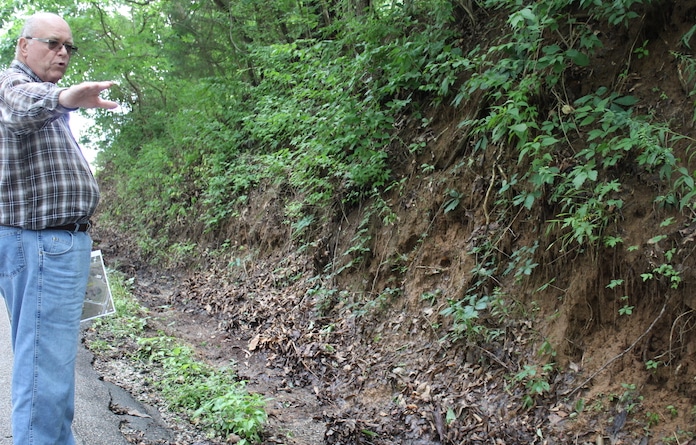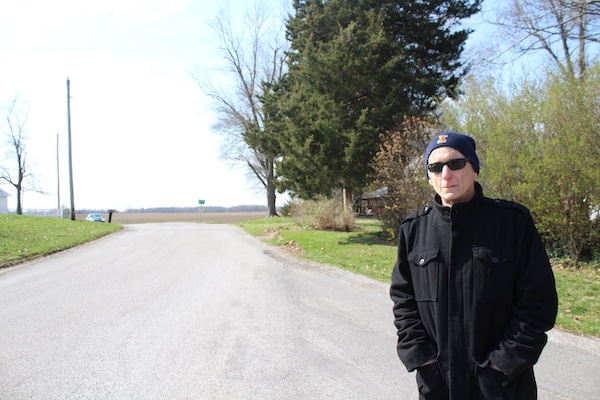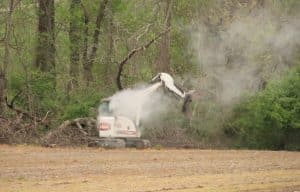Road District 5 concerns raised

Some residents of Monroe County Road District 5 are sounding the alarm on what they believe to be hazardous road conditions, from potholes to alleged flood submerged electrical boxes.
Road District 5 comprises the Columbia area and is managed by elected road district commissioner Ed Breeding.
Recently, residents of EE Road near the Monroe County YMCA and those who live along a portion of Steppig Road are alleging subpar road conditions – some of which can lead to serious safety issues, they say.
Next door neighbors James Eames and Bob Schueler live on Steppig Road at the bottom of a large hill. Eames said he has been experiencing “life safety issues” with the road for decades.
Due to the road’s downward slope and a culvert, rainwater is directed to the lowermost part of the road, which Eames describes as a “natural sinkhole.” The culvert causes water to run under the road and when it gets overwhelmed, flooding begins.
Eames said the culvert is too small to handle substantial rainwater and is often clogged with branches and debris, further limiting its capacity.
Feeling as though the problem would not be fixed – even though Eames said the county had once told him they would “take care of it” – Schueler installed another culvert on county property.
This, Eames said, did not make much of a difference.
Eames said the most alarming aspect of the flooding is not only are drivers forced to drive through two or more feet of water, but an electrical box on the left side of the road is submerged in that same rainwater.
Eames believes the solution to this problem is simple.
“A bigger pipe would do the trick,” he said, adding the creek and culvert would need to be cleaned.
Breeding said he is aware of both Eames’ and Schueler’s concern and has talked with Monroe County Engineer Aaron Metzger and “landowners” about putting in a detention pond with the hope of slowing the flow of water down enough to where the pipe can manage it.
Breeding said this would, in turn, reduce the amount of water on the road.
Yet, Breeding said there is not a perfect solution.
“Maybe that will (reduce the flooding),” Breeding said. “But, if you get 3-4 inches of rain, I don’t care what kind of pipe you have, you’re going to have a problem.”
Eames said he had not been aware of this plan.
Eames has also raised concerns about visibility on Steppig Road, stating it is particularly hard for those pulling out of Eagle Lakes subdivision and those traveling on Steppig Road to see each other. There is no stop sign at this intersection, despite Eames and Schueler advocating for one.
Large farming equipment also relies on this road, the men said.
Breeding explained that trees skewing visibility at the subdivision intersection were trimmed to address such concerns.
This is something Eames had been advocating for, as there is no place to pull over along the road. There is also no speed limit posted on the section in question. Eames fears these two factors could be a lethal combination.
After writing a letter to the editor published in a past issue of the Republic-Times, Eames said the road was oiled and chipped – yet potholes were not patched.
Columbia resident Brian Zapf lives in the Christopher Lake subdivision and said he has been dealing with problems on EE Road, which leads to his subdivision and others, for over 20 years.
“It keeps falling on deaf ears,” Zapf said. “Trying to get them to move is like trying to move a mountain.”
He said the road is riddled with potholes.
“Our road looks like Afghanistan pipe bombs went off,” Zapf said, referring to potholes.
Zapf acknowledged Breeding recently had some potholes patched, yet he said there is much more to be done. As a past precinct committeeman, Zapf was able to get the portion of the road spanning from the YMCA entrance to his subdivision widened in the early 2000s, but the rest is still narrow and winding.
During crop season, visibility is compromised, making it challenging to see other cars on the roadway, Zapf said. He added the road is too narrow for two cars traveling in opposite directions to safely pass each other and there is no shoulder to pull off on.
This would require one, if not both, of the cars to drive on potholes lining the road, Zapf said.
The road’s width also requires bikers and other pedestrians to travel in the middle of the road.
“Somebody is going to get hit. It’s just a matter of when,” Zapf said.
Breeding said there is not much he can do to keep the roads patched in the winter.
“Between rain, freezing and thawing, the roads go to heck,” Breeding said. “As soon as we get decent weather, they’ll be addressed.”
Breeding said after remaining potholes are patched, the edges of the road will be oiled. Then, in July, the entirety of EE Road will be oiled.
“It’s plenty wide. We just have to fix the edges and then we’ll be good to go,” Breeding said.
Without a speed limit posted on EE Road, people assume they can continue going 55 miles per hour as is posted on Route 3, Zapf said, adding that is way too fast for this road.
He also noted that heavy rains can cause flooding, as water from the fields has nowhere to go. At present time, the sections of EE Road and Gilmore Lake Road that Zapf is worried about do not have culverts to help direct or hold water.
Like Eames and Schueler, there is a particular intersection Zapf is concerned about: Gilmore Lake Road at EE Road.

Here, four different pathways intersect – one leading out of a subdivision to be met with a stop sign. There is another stop sign at EE Road, which Zapf said “does not make sense,” as people stop there after going fast down the road yet two other avenues don’t have to yield.
Zapf explained there is limited visibility at the intersection, and this is exasperated once crops start growing.
Zapf told Breeding he thinks installing mirrors on telephone poles at the intersection would help drivers see around the bends of the intersection.
That, Breeding said “is a sore subject.”
Breeding told the Republic-Times he is wary of installing mirrors as he feels it will just be damaged by kids. He said much of the visibility problem is due to farmland that extends out to the road and it is within the farmer’s rights to farm up to the road.
“There’s nothing that can be done there to better that intersection,” Breeding said.
Zapf maintains that because of the issues he outlined above, the employment of Breeding and the tax levy his subdivision pays toward Road District 5 is “the worst waste of taxpayer money.”
The 2020 levy, payable in 2021, was 0.54256, according
to 2021 road district financial data. The report also said the greatest expenditure for Road District 5 in 2020-21 was for equipment purchases, the second being the combined commissioner and clerk salaries.
This figure places Breeding’s annual salary at $48,906.
Breeding was the second highest paid road district commissioner in Monroe County for that year.
Each road district clerk’s annual salary is $2,650.






